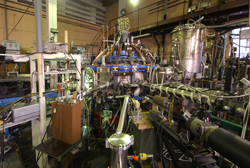Making negative ion beams of superior quality possible
Eventually, new techniques, which are under development, will ensure the lowest possible emittance for particle beams produced when negative hydrogen ions are accelerated and subjected to magnetic compression. In response to the technical challenge posed by the next generation of high power proton accelerators, the Fifth Framework Programme funded, in part, the HP NIS project. Several teams from European laboratories offered their experience and expertise to develop negative hydrogen ion sources with a reliability that had not as yet been reached. Researchers at Frankfurt University in Germany provided a suite of diagnostic instruments for detailed measurements of the ion beam properties. This meant applying non-destructive techniques that allow on-line measurements while the accelerator is operational. Negative hydrogen ions offer the opportunity of non-destructive beam diagnostics based on the effect of photo-detachment. Through the interaction of negative hydrogen ions and laser light with a wavelength between 600 and 1100nm, the additional electron can be detached and a small number of neutral atoms is produced. An additional magnetic field can then be used to separate the detached electrons and neutral atoms from ions. Moreover, the number and distribution of either the detached electrons or the neutral atoms produced can be analysed while the ion beam is still in use. Different detector systems with spatial resolution were designed to investigate the full three-dimensional density distribution of the neutralised atoms. As neither the laser photons nor the detached electrons transfer significant momentum to the neutralised atoms, their distribution would be the same as the distribution of the primary ion beam. A time-of-flight (TOF) scintillator used the detached electrons to deliver the transversal and longitudinal density distribution of the primary ion beam. A second scintillator with spatial resolution detected, together with a charge-coupled device (CCD) camera the neutralised atoms to estimate tranverse emittance. Diagnostic experiments conducted at the laboratories of the Frankfurt University revealed the advantages of beam diagnostics that have no mechanical parts intercepting the ion beam over conventional beam diagnostics.



